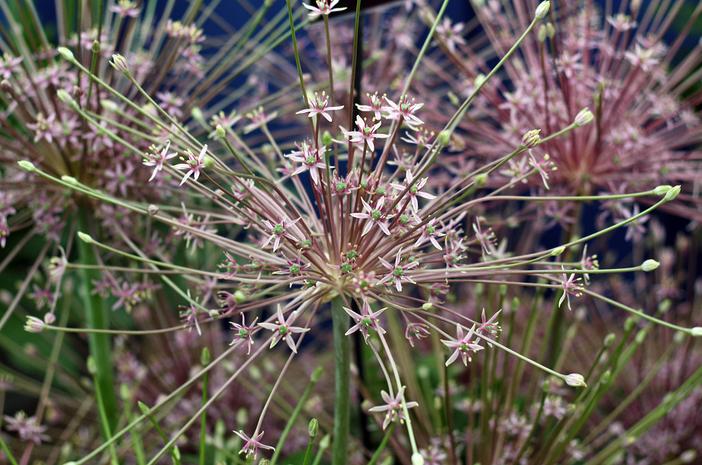Ornamental Onion
(Allium schubertii)
Ornamental Onion (Allium schubertii)
/
/

Tanya Hart
CC BY-SA 2.0
Image By:
Tanya Hart
Recorded By:
Copyright:
CC BY-SA 2.0
Copyright Notice:
Photo by: Tanya Hart | License Type: CC BY-SA 2.0 | License URL: https://creativecommons.org/licenses/by-sa/2.0/ | Uploader: arripay | Publisher: Flickr



















Estimated Native Range
Summary
Allium schubertii, commonly known as Ornamental Onion, is a perennial herb that is part of the Allium genus, which includes onions and garlic. It is native to the Middle East, specifically to arid regions with well-drained soils. This plant typically grows to about 50 cm in height and has a lifespan of 2–5 years. Allium schubertii is characterized by its underground bulb and vivid green, strap-like leaves that emerge in the spring. The foliage dies back before the plant blooms. Its flowers are a dramatic display of 50 or more star-shaped, mauve florets on stems of varying lengths, creating a starburst effect that can span up to 30 cm across. After flowering, the desiccated flower heads detach from the dead stems and can be dispersed by the wind, scattering seeds as they tumble across the landscape.
The Ornamental Onion is celebrated for its unique and showy flower heads, which resemble exploding fireworks, making it a popular choice for ornamental gardens. The dried flower and seed heads are also used in floral arrangements and can be painted for decorative purposes, such as Christmas tree ornaments. Allium schubertii thrives in full sun and prefers well-drained soil with low to medium moisture levels. It is suitable for AHS planting zones 5-8, though it may be more cold-hardy depending on soil conditions. Heavy soils that retain water can negatively impact the plant’s survival during winter. In cultivation, it is often used in rock gardens, borders, and as a focal point in xeriscaping due to its drought tolerance and striking appearance. Gardeners should be aware that while it is generally low-maintenance, it can be susceptible to bulb rot if overwatered or planted in poorly drained soils.CC BY-SA 4.0
The Ornamental Onion is celebrated for its unique and showy flower heads, which resemble exploding fireworks, making it a popular choice for ornamental gardens. The dried flower and seed heads are also used in floral arrangements and can be painted for decorative purposes, such as Christmas tree ornaments. Allium schubertii thrives in full sun and prefers well-drained soil with low to medium moisture levels. It is suitable for AHS planting zones 5-8, though it may be more cold-hardy depending on soil conditions. Heavy soils that retain water can negatively impact the plant’s survival during winter. In cultivation, it is often used in rock gardens, borders, and as a focal point in xeriscaping due to its drought tolerance and striking appearance. Gardeners should be aware that while it is generally low-maintenance, it can be susceptible to bulb rot if overwatered or planted in poorly drained soils.CC BY-SA 4.0
Plant Description
- Plant Type: Bulb
- Height: 1-2 feet
- Width: 1-1.5 feet
- Growth Rate: Moderate
- Flower Color: Pink, Purple
- Flowering Season: Spring
- Leaf Retention: Deciduous
Growth Requirements
- Sun: Full Sun
- Water: Low
- Drainage: Medium
Common Uses
Bee Garden, Bird Garden, Butterfly Garden, Deer Resistant, Drought Tolerant, Fragrant, Hummingbird Garden, Low Maintenance, Potted Plant, Rabbit Resistant, Rock Garden, Showy Flowers
Natural Habitat
Native to arid regions with well-drained soils in the Middle East
Other Names
Common Names: Tumbleweed Onion , Persian Onion , Flowering Onion , Fyrverkerilök
Scientific Names: Allium schubertii
GBIF Accepted Name: Allium schubertii Zucc.